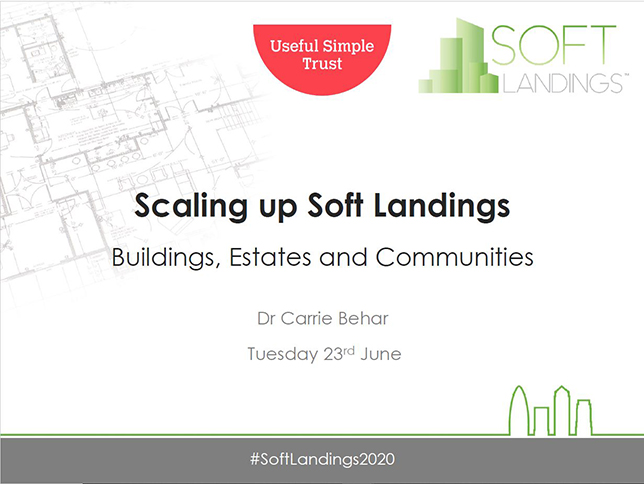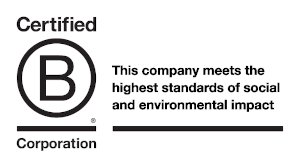Soft Landings can help us #Buildbackbetter
As we emerge from the Coronavirus lockdown and start to resume something approximating ‘normal’ life, the need to understand building performance and ensure our built environment delivers on its social and environmental purpose has never been more urgent.
Soft Landings is a process and approach to designing and constructing buildings based on “improving operational performance of the building and meeting the client’s expectations”[1]. It was developed by BSRIA, with a focus on closing the energy performance gap in buildings. However, it has the potential for much wider application, as a framework and vehicle for the delivery and operation of sustainable buildings, neighbourhoods, and cities.
In this blog, Carrie Behar shares some insights from her own research, as well as Useful Projects’ work on improving building performance and implementing Soft Landings approaches. This is based on her recent presentation at the BSRIA Soft Landings Conference 2020.
[1] https://www.bsria.com/uk/consultancy/project-improvement/soft-landings/
The need for a more holistic and engaging building delivery process
The standard processes for funding, design, and construction of buildings in the UK does not put actual building performance at the centre of decision making. Instead, the focus is on return on investment, compliance via theoretical building performance, and risk management. Research I carried out as part of my PhD, showed first-hand what happens when you focus on ‘users’ or ‘occupants’, rather than putting real people, and their diverse needs, at the heart of the design process.
While exploring how residents of ‘low energy’ housing with innovative whole house ventilation technologies were ventilating their homes, I observed a mismatch between what the architects anticipated was taking place in the occupied dwellings, and the reality of the lived experience. For example, high level rooflights, designed with ‘night purge ventilation’ in mind, and requiring a long pole to open, were routinely being left closed, because of concerns about water ingress, mosquitoes and other insects getting in, in addition to and particularly concerningly, because the pole wasn’t provided to residents and there was no other safe way to access the opening.
In another example, residents were unaware of having certain systems in their homes, let alone that they required regular maintenance. The information provided in building user guides was, at best, confusing; technologies were hidden away in inaccessible locations, and the reality of life meant that people had more pressing concerns than changing a filter on a ventilation unit. My investigation of domestic ventilation routines made it very clear that individuals do not always use technologies according to the design intent. This is probably exacerbated by the evident lack of coordinated and helpful handover processes. Is it any wonder then that actual energy consumption in buildings is often at least twice as much as predicted?
How Soft Landings can help unlock value in refurbishment projects
In 2016 the Useful Simple Trust moved into a new workspace in a former clove warehouse in Bermondsey. We inherited a Cat-A fit out and had the opportunity to design the interior spaces to suit our needs. As designers and engineers with a strong sustainability agenda, we were committed to undertaking a sustainable refurbishment, and made a conscious decision to adopt practices from Soft Landings, to help us get the most value out of our investment.
Early on in the process, before we had even selected our new workspace, we ran a series of visioning and engagement sessions with the whole office, to explore ideas for creating a happy, healthy and productive working environment. We spent some time reflecting on what practices we’d like to leave behind in the old office, as well as discussing what we appreciated and felt was already working well, and therefore wanted to take with us to the new workplace.
We also arranged visits to the new space before we moved in, and prepared an engaging and informative welcome pack for all staff, as part of our graduated handover. The design work was carried out by our colleagues at Useful Studio, and was based on an adaptable, pared back and light touch approach that reduced material consumption and accentuated the industrial heritage of the building. The results of our post occupancy evaluation were overwhelmingly positive, verifying that our design and handover strategies were effective, as well as highlighting areas where some adjustments were required, and providing a useful forum for engaging our colleagues in discussions about building performance and workplace design.
Scaling up: Soft Landings at a University Estate
Whilst applying Soft Landings on individual buildings is has important value, the real challenge is in scaling it up to cover whole estates, neighbourhoods, and sectors. University estates have been at the forefront of adopting Soft Landings, with UCL, the University of the West of England and the University of Oxford, among others, putting in place frameworks and protocols around improving building performance in use. This is testament to the fact that in developer-owner situations, where the client has responsibility for the long term stewardship of a building, Soft Landings delivers true benefits; it also serves as an indictment of more commercial development models that prioritise short term profit over whole life benefits.
In 2018, we worked with UCL Estates to set up and run the Soft Landings process on a major new development project – the provision of a new home for the Institute of Neurology and UK Dementia Research Headquarters. A thorough mapping of the UCL Estates roles against the Soft Landings framework revealed hotspots where actions could slip between the gaps, as well as highlighting the importance of appointing the right ‘Champion’ to connect such a diverse group of stakeholders and help them develop a consensus around building performance. On this project Soft Landings has been particularly effective in bringing forward discussions which would otherwise have happened much later on.
We also worked with UCL to set up an estate-wide Soft Landings process, based on a tailored version of the BSRIA framework. Creating a bespoke framework was essential to ensure that the right people and teams are involved at the appropriate stage in the procurement process, to empower project managers and to maintain that essential ‘golden thread’ through a project. This is supporting the implementation of Soft Landings across the whole UCL estate, which comprises over 200 buildings across London, including in Bloomsbury and Stratford. Soft Landings is now a contractual requirement on all UCL capital projects over £2m. This work has helped embed building performance at the strategic and policy levels, an approach which is much needed to achieve a net zero transition across the UK’s building stock.
Social value and Soft Landings
Currently, there is a much-needed interest around how construction and development can contribute towards economic recovery and the creation of social value. In 2019, Useful Projects led a piece of research around maximising social value in infrastructure, supported by funding from the ICE. We found that much of the discussion around social value in infrastructure was often focused on how we build (i.e. in terms of creation of construction jobs, apprenticeships etc.), often neglecting to consider whether what we are building in the first place offers the best benefit to society, as well as how that asset is being operated over its whole life.
In reality, we all know that much of the benefit of buildings comes over the course of their whole operational life. Building performance is key part of the ‘operation’ stage – ultimately buildings are here to serve people; therefore, they need to be designed to serve people in the best manner possible, allowing individuals, communities and society to thrive.
Soft Landings is, and could be, about more than just energy performance in buildings. Its effective application also addresses comfort, health and wellbeing and all the other activities associated with our whole built environment, including the infrastructure that supports and connects them. I’m looking forward to seeing how Soft Landings gains traction it will be applied at the community, neighbourhood and even city scale to support development with purpose and for prosperity.




